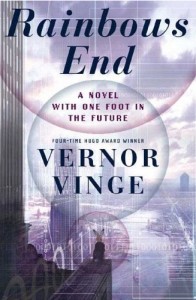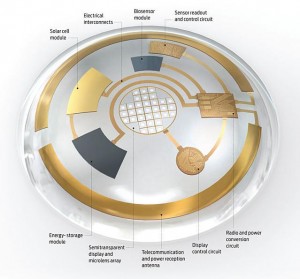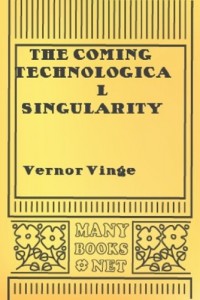Interview with Vernor Vinge
Tish Shute: Many of the pioneers of the emerging AR industry who will be speaking at, and attending Augmented Reality Event, consider “Rainbows End” one of their key inspirations. [Note: If you want to attend ARE2011 readers of this post can use my discount code TISH295 ($295 for two days, or for one day only TISH1DAY11 for $149]
What is the best and worst, in your view, about the way Augmented Reality is emerging from science fiction into science fact?
Vernor Vinge: Progress that sets the stage:
The worldwide market penetration of cellphones in the era 2000-2010 was of a size and speed that would have counted as foolish implausibility even in science-fiction of earlier times. More than half the human race suddenly had access to knowledge and comms. Being in the middle of this firestorm of progress, we can’t really judge ultimate effects, but I expect that smart phones and the empowering aspects of social networks and AR are still massively underhyped. (This is not to say that individual innovation enterprises can’t fail; the treasure is there for those who dare, and ultimately the whole human race can benefit.)
But I can still whine:
Some — mostly political/legal — issues are disappointing. These affect AR but also the broad range of our progress with technology:
o Software patents and some styles of cloud computing are blunting the ability of average people to innovate. In the 2010-2020 era, average people should have the building blocks to empower them to create (and throw away at the end of the workday) tools that in olden times would have been the whole purpose of a business startup.
Unfortunately, some companies restrict and compartmentalize their releases like we’re still living in the twentieth century.
There are also some mostly tech issues that I’m impatient with (speaking as a never-satisfied consumer and fan:)
o The low pixel counts in contemporary head up displays.
o The poor position coordination in current HUDs.
o The lack of mass market acceptance of HUDs.
o The lack of progress in distributed store-and-forward between
mobile devices (sub-femtocell, ad hoc and transitory forwarding).
o The lack of progress in uniform solutions to centimeter-scale
localization.
Tish Shute: What do you feel will be the most impactful application of AR in people’s everyday lives?
Vernor Vinge: There are nebulous and fairly high likelihood answers: AR apps that let each person/team see those aspects of physical reality that are important for their current activity. Pointing technologies that coordinate with that AR vision. The combination is a revolution of interfaces, and the probable physical disappearance of more and more of the gadgets that twentieth century people associated with high tech.
There are also more specific, spectacular, and necessarily uncertain impacts (that depend on social acceptance and the development of network infrastructure for consensual sharing of local imagery).
o Economic disruption of the trend toward huge, expensive display devices.
o Bottom up social networking, arising from GPL’d tools. I see this as very disruptive, in good, bad and arguable ways, as illustrated by descriptive terms such as “consumer protection clubs”, “belief circles” and “lifestyle cults”. Some of these could be as public as our topdown social networks. Some might be quiet and widespread, perhaps growing out of pre-existing groups that already have a lot of intermember trust. (See:http://www-rohan.sdsu.edu/faculty/vinge/C5/index.htm)
o More farfetched, but in the tradition of the last 50 years: the digitization of external visual design: building architecture could give less priority to physical appearance and more to cheap physical strength, network access support, and physical modifiability.
Tish Shute: I interviewed Bruce Sterling earlier this week – http://www.ugotrade.com/2011/05/06/augmented-reality-transitioning-out-of-the-old-fashioned-legacy-internet-interview-with-bruce-sterling/. And, I’m really looking forward to your “fireside chat” with Bruce at the end of Augmented Reality Event to sum up the event [see the full schedule for ARE2011 here]. But was there anything that particularly rung a bell for you in my conversation with Bruce?
Vernor Vinge: Bruce says: “… it’s pretty clear that the people who would weep for joy to have Augmented Reality are people whose reality is already damaged. People who need reality augmented as a prosthetic …” This really rings a bell with me. And social networks with AR may have a special impact at small sizes, even just _two_ players. At such a scale, they might be better called “joint entities” than “social networks”. For example, two differently disabled persons, where one is mobile. There’s a lot more that could be said about this, including applications that could be done (maybe are being done) already.
Picture via IEEE Spectrum: Augmented Reality in a Contact Lens
Tish Shute: As Jesse Schell pointed out last year at ARE2010, “The whole point of AR is to see things from a different point of view … How can there be a more powerful art form than one that actually changes what you see?”
The magic lens of the smart phone, screens – large and small, projection, audio and sensory devices are mediating our AR experiences today. Bruce pointed out last year in his opening keynote, that these less immersive forms of AR have their own merits.
But eyewear has always been integral to the big vision of AR. Do you see some interesting futures for AR without eyewear? And, How long before AR eyewear is part of our everyday lives?
Vernor Vinge: This importance of vision is a visionist claim ![]() , but for the majority of us who have sight, binocular vision is by far the highest bitrate input we have, and we have enormously sophisticated wetware for analyzing what we see. Current display tech is far short of fully exploiting this input channel.
, but for the majority of us who have sight, binocular vision is by far the highest bitrate input we have, and we have enormously sophisticated wetware for analyzing what we see. Current display tech is far short of fully exploiting this input channel.
Along the way to this goal, I expect we’ll pass through mini-eras of exploiting the best-available tech. Right now, that is the tablet and the smartphone. Sometimes I almost wish for slower progress: in the nineteenth century, you could profitably spend your tech lifetime mastering one mechanism (for instance, black-and-white silver halide photography). The whole world would benefit from your career. Now, we rattle through the mini-eras so fast that we never fully exploit what’s zooming past before we’re on to the next stage.
How fast (or if) HUDs like in Rainbows End show up will probably depend on network and localizer tech as much as the HUDs themselves, with clear generational differences within such eyeware. In fact, it’s fun to imagine the mini-eras you could get with different combinations of HUDs tech, localization, and networking.
(Aside, a quibble: I think AR should not be restricted to visual only. There are tactile and kinesthetic possibilities, at least.)
(Aside, a whine: If only we had an output channel with the bitrate and flexibility of vision! Wearables plus voice and gesture could do some of that. Going further might involve scary human re-engineering. In Fast Times at Fairmont High, I speculated that a small re-engineering (eidetic memory) could give a form of highrate output,
simply by allowing selection from very large menus.)
Tish Shute: Augmented Reality and Ubiquitous Computing are intimately connected. Is a distinction between AR and Ubicomp still useful? (This recent PARC blog post: http://blogs.parc.com/blog/2010/03/defining-ubiquitous-computing-vs-augmented-reality/ takes a look at the definitions.)
Vernor Vinge: In a literal sense there is a distinction, and there is enough technical challenge in AR to justify specialists spending all their time with AR. But Augmented Reality’s importance to humanity is in its role as a portal to the power of ubicomp and human cooperation.
Tish Shute: Augmented Reality, as we understand it now, is a human centered experience. But even now some of the most important aspects of our lives are governed by machine to machine intelligences that operate for the most part beyond the reach of human perception, e.g., the trading bots of Wall Street. What role can augmented reality play in better mediating between human intelligence and machine to machine intelligence? Does AR hasten the arrival of the technological singularity?
Vernor Vinge: I see four or five concurrently active paths to the Singularity:
a) Artificial Intelligence: We create superhuman artificial intelligence in computers.
b) Digital Gaia: The worldwide network of embedded microprocessors, sensors, effectors, and localizers becomes a superhumanly intelligent entity.
c) Internet Scenario: Humanity with its networks, computers, and databases becomes a superhuman being. (Bruce’s story “Maneki Neko” is a beautiful and subtle illustration of this possibility.)
d) Intelligence Amplification: We enhance individual human intelligence through human-to-computer interfaces.
e) Biomedical: We directly increase our intelligence by improving the neurological function of our brains. (I regard this last item to be the weakest of the possibilities.)
AR is central to progress with possibilities (c) and (d).
If we humans want to keep our hand in the game, AR is an important thing to pursue.
Tish Shute: Powerful computer vision apps are emerging for smart phones and face recognition technologies are beginning to appear in consumer apps. Do you think we need a major shift in the way we handle data ownership? And, is “there is a real risk of our augmented reality world being owned by interests which are not our own?” (see my conversation with Anselm Hook last year. http://www.ugotrade.com/2010/01/17/visual-search-augmented-reality-and-a-social-commons-for-the-physical-world-platform-interview-with-anselm-hook
Vernor Vinge: Yes, there is such a risk. (See also my political/legal comments in response to your question (1).)
More broadly, I see DRM and the Law being used to reify our intellectual heritage as permanent private property. If this could work, it would be the biggest grab in history — and a major roadblock on human progress.
But even setting aside all the open/closed/free ideological questions, there is another important issue here: anytime laws are passed making popular and easily accomplished behavior illegal, things get very ugly. It may seem frivolous to compare this to the first stages of the War on Drugs, but that’s where serious enforcement would lead.
Tish Shute: We have seen gestural interfaces go mainstream in the last year. What are the most interesting innovations with gestural interfaces that you have seen in recent months? What sessions will you go to at ARE this year?
Vernor Vinge: I’m way behind the curve as to what is happening right now. Collecting data points on real hardware and applications is a high priority for me in attending ARE 2011.
Tish Shute: Are you reading/writing any new fictional literature about AR? And/or, What design fictions for AR are most interesting to you in the moment?
Vernor Vinge: As to writing: My novel The Children of the Sky should come out this October from Tor Books. It’s set in the far future and is the sequel to A Fire Upon the Deep. Alas, the story has only indirect connections to our present technological interests.
As to reading: I got a big kick out of Daniel Suarez’s duology Daemon and Freedom(TM).




